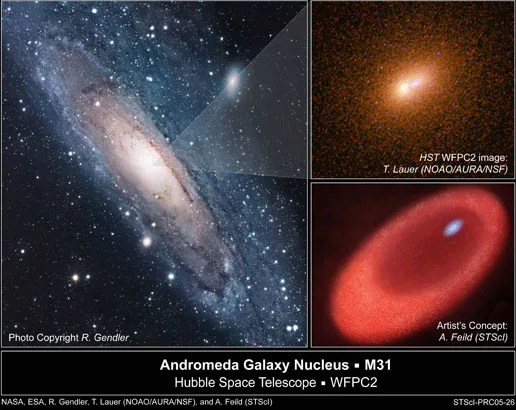4 min read
Astronomers using NASA's Hubble Space Telescope have identified the source of a mysterious blue light surrounding a super-massive black hole in our neighboring Andromeda Galaxy (M31). The strange light has puzzled astronomers for more than a decade.

Image above:
Andromeda and its complex core can be seen in the illustration and two images [above]. The illustration [lower, right] shows the disk of blue stars nested inside a larger ring of red stars. The Hubble photo [upper, right] reveals Andromeda’s bright core. The image at left shows the entire galaxy. Credits: (Image left) copyright 2002 R. Gendler, Photo by Robert Gendler/ (Image top right) NASA/ESA/T. Lauer (NOAO/AURA/NSF)/(Image bottom right) NASA/ESA/A. Feild (STScI)
The blue light is coming from a disk of hot, young stars whipping around the black hole in much the same way as planets in our solar system are revolving around the sun. Astronomers are perplexed about how the pancake-shaped disk of stars could form so close to a giant black hole. In such a hostile environment, the black hole's tidal forces should tear matter apart, making it difficult for gas and dust to collapse and form stars. These observations, astronomers say, may provide clues to the activities in the cores of more distant galaxies.
By finding the disk of stars astronomers have collected what they say is ironclad evidence for the existence of the super-massive black hole. The evidence has helped astronomers rule out all alternative theories for the dark mass in Andromeda's core, which scientists have long suspected was a black hole.
"Now that we have proven that the black hole is at the center of the disk of blue stars, the formation of these stars becomes hard to understand," said Ralph Bender of the Max Planck Institute for Extraterrestrial Physics in Garching, Germany. "Gas that might form stars must spin around the black hole so quickly that star formation looks almost impossible. But the stars are there," he added.
"Seeing these stars is like watching a magician pulling a rabbit out of a hat. You know it happened but you don't know how it happened," said Todd Lauer of the National Optical Astronomy Observatory in Tucson, Ariz. He and a team of astronomers, led by Bender and John Kormendy of the University of Texas in Austin, made the Hubble observations. The results will be published in the September 20, 2005, issue of the Astrophysical Journal.
As far back as 1995, Hubble revealed a strange blue light in Andromeda's core that astronomers said might have come from a single, bright blue star or perhaps from a more exotic energetic process. Follow-up observations with Hubble in 1998 suggested that the light is a cluster of blue stars.
New observations by the Hubble's Imaging Spectrograph (STIS) reveal that the blue light consists of more than 400 stars that formed in a burst of activity about 200 million years ago. The stars are tightly packed in a disk only a light-year across. The disk is nested inside a ring of older, redder stars, seen in previous Hubble observations.
The astronomers also used STIS to measure the velocities of those stars. They obtained the stars' speeds by calculating how much their light waves are stretched and compressed as they travel around the black hole. Under the black hole's gravitational grip, the stars are traveling very fast: 2.2 million miles an hour. They are moving so fast it would take the stars 40 seconds to circle the earth and only six minutes to arrive at the moon.
While astronomers are surprised to find a disk of stars swirling around a super-massive black hole, they believe the puzzling architecture may not be that unusual. "The dynamics within the core of this neighboring galaxy may be more common than we think," Lauer said. "Our own Milky Way apparently has even younger stars close to its own black hole. It seems unlikely that only the closest two big galaxies should have this odd activity," he added.
For imagery and additional information about the research on the Internet, visit:
Susan Hendrix
Goddard Space Flight Center







